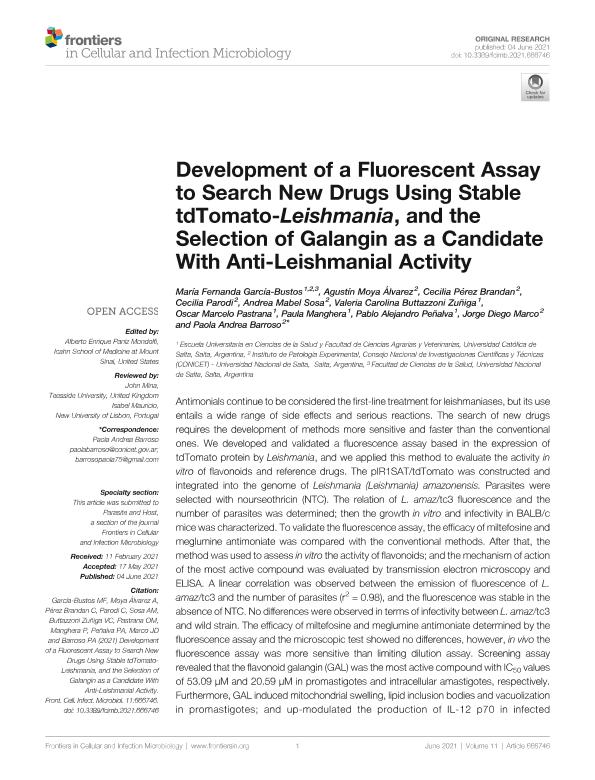Artículo
Development of a Fluorescent Assay to Search New Drugs Using Stable tdTomato-Leishmania, and the Selection of Galangin as a Candidate With Anti-Leishmanial Activity
Garcia Bustos, Maria Fernanda ; Moya Alvarez, Agustin
; Moya Alvarez, Agustin ; Pérez Brandan, Cecilia María
; Pérez Brandan, Cecilia María ; Parodi Ramoneda, Cecilia María
; Parodi Ramoneda, Cecilia María ; Sosa, Andrea Mabel
; Sosa, Andrea Mabel ; Buttazzoni Zuñiga, Valeria Carolina; Pastrana, Oscar Marcelo; Manghera, Paula Mariana; Peñalva, Pablo Alejandro; Marco, Jorge Diego
; Buttazzoni Zuñiga, Valeria Carolina; Pastrana, Oscar Marcelo; Manghera, Paula Mariana; Peñalva, Pablo Alejandro; Marco, Jorge Diego ; Barroso, Paola Andrea
; Barroso, Paola Andrea
 ; Moya Alvarez, Agustin
; Moya Alvarez, Agustin ; Pérez Brandan, Cecilia María
; Pérez Brandan, Cecilia María ; Parodi Ramoneda, Cecilia María
; Parodi Ramoneda, Cecilia María ; Sosa, Andrea Mabel
; Sosa, Andrea Mabel ; Buttazzoni Zuñiga, Valeria Carolina; Pastrana, Oscar Marcelo; Manghera, Paula Mariana; Peñalva, Pablo Alejandro; Marco, Jorge Diego
; Buttazzoni Zuñiga, Valeria Carolina; Pastrana, Oscar Marcelo; Manghera, Paula Mariana; Peñalva, Pablo Alejandro; Marco, Jorge Diego ; Barroso, Paola Andrea
; Barroso, Paola Andrea
Fecha de publicación:
04/06/2021
Editorial:
Frontiers Media
Revista:
Frontiers in Cellular and Infection Microbiology
ISSN:
2235-2988
Idioma:
Inglés
Tipo de recurso:
Artículo publicado
Clasificación temática:
Resumen
Antimonials continue to be considered the first-line treatment for leishmaniases, but its use entails a wide range of side effects and serious reactions. The search of new drugs requires the development of methods more sensitive and faster than the conventional ones. We developed and validated a fluorescence assay based in the expression of tdTomato protein by Leishmania, and we applied this method to evaluate the activity in vitro of flavonoids and reference drugs. The pIR1SAT/tdTomato was constructed and integrated into the genome of Leishmania (Leishmania) amazonensis. Parasites were selected with nourseothricin (NTC). The relation of L. amaz/tc3 fluorescence and the number of parasites was determined; then the growth in vitro and infectivity in BALB/c mice was characterized. To validate the fluorescence assay, the efficacy of miltefosine and meglumine antimoniate was compared with the conventional methods. After that, the method was used to assess in vitro the activity of flavonoids; and the mechanism of action of the most active compound was evaluated by transmission electron microscopy and ELISA. A linear correlation was observed between the emission of fluorescence of L. amaz/tc3 and the number of parasites (r2 = 0.98), and the fluorescence was stable in the absence of NTC. No differences were observed in terms of infectivity between L. amaz/tc3 and wild strain. The efficacy of miltefosine and meglumine antimoniate determined by the fluorescence assay and the microscopic test showed no differences, however, in vivo the fluorescence assay was more sensitive than limiting dilution assay. Screening assay revealed that the flavonoid galangin (GAL) was the most active compound with IC50 values of 53.09 µM and 20.59 µM in promastigotes and intracellular amastigotes, respectively. Furthermore, GAL induced mitochondrial swelling, lipid inclusion bodies and vacuolization in promastigotes; and up-modulated the production of IL-12 p70 in infected macrophages. The fluorescence assay is a useful tool to assess the anti-leishmanial activity of new compounds. However, the assay has some limitations in the macrophage-amastigote model that might be related with an interfere of flavanol aglycones with the fluorescence readout of tdTomato. Finally, GAL is a promising candidate for the development of new treatment against the leishmaniasis
Palabras clave:
FLUORESCENT
,
DRUGS
,
LEISHMANIA
,
GALANGIN
Archivos asociados
Licencia
Identificadores
Colecciones
Articulos(IPE)
Articulos de INST.DE PATOLOGIA EXPERIMENTAL
Articulos de INST.DE PATOLOGIA EXPERIMENTAL
Citación
Garcia Bustos, Maria Fernanda; Moya Alvarez, Agustin; Pérez Brandan, Cecilia María; Parodi Ramoneda, Cecilia María; Sosa, Andrea Mabel; et al.; Development of a Fluorescent Assay to Search New Drugs Using Stable tdTomato-Leishmania, and the Selection of Galangin as a Candidate With Anti-Leishmanial Activity; Frontiers Media; Frontiers in Cellular and Infection Microbiology; 11; 4-6-2021; 1-13
Compartir
Altmétricas



